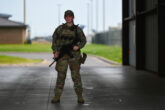July 22, 2014
Beyond UCLASS: Preparing the Navy for Next Generation Warfare
The United States is the world’s leading military power in large part because it employs both the best military technologies in the world and the best-trained force to effectively use those technologies. Yet staying ahead is no easy task. Just as in the corporate world, the same ways of doing business that led to success in the past can, especially during periods of rapid technological change, place future superiority at risk.
Critical to maintaining the U.S. military’s advantage over the next few decades will be ensuring it has the organizational capital to fully take advantage of and integrate an emerging generation of technologies. An early test may be the U.S. Navy’s pending acquisition decision regarding a new carrier-based unmanned aircraft, the unmanned carrier-launched airborne surveillance and strike program (UCLASS).
Washington’s defense intelligentsia has spent the past year considering how the UCLASS system will evolve. Will the UCLASS be bat-shaped, stealthy, speedy, and packed with kinetic power — everything that the experimental X-47B UCAS-D suggested was possible? Alternatively, will it look more like a dragonfly — focused on an intelligence, surveillance, and reconnaissance missions with limited strike, akin to existing medium-altitude long-endurance platforms operated by the Army and Air Force today? In recent testimony before the House Armed Services Committee on the topic, experts drilled into the costs and benefits of the two approaches. Two of the witnesses, Sean Brimley and Bryan McGrath, also took their argument to War on the Rocks. The testimony suggested that the choice the Navy makes on UCLASS may influence the fate of the aircraft carrier in an age of anti-access technologies, and with it U.S. power projection.
More from CNAS
-
National Security Human Capital Program
Short SupplyExecutive Summary The U.S. military faces a critical challenge: Fewer young Americans are willing to serve, and fewer adults are encouraging them to do so. Because of delibera...
By Katherine L. Kuzminski & Taren Sylvester
-
National Security Human Capital Program
Defending the Army’s Command Assessment ProgramThe concept for CAP — developed during the first Trump administration — benefited from the guidance, input and oversight from the foremost scholar and practitioner on military...
By Katherine L. Kuzminski
-
National Security Human Capital Program
‘Women Don’t Just Achieve…They Excel’: Fmr. Marine Corps Attack PilotDr. Kyleanne Hunter, former Marine Corps attack pilot and CEO of Iraq & Afghanistan Veterans of America, says “women are the fastest growing group of veterans” and “the fastes...
By Dr. Kyleanne Hunter
-
National Security Human Capital Program
A Workforce Strategy for America’s Shipbuilding FutureThe future of American maritime dominance will not be determined solely by the number of ships launched or contracts signed, but rather by the strength and sustainability of t...
By Katherine L. Kuzminski & Laura Schmiegel




